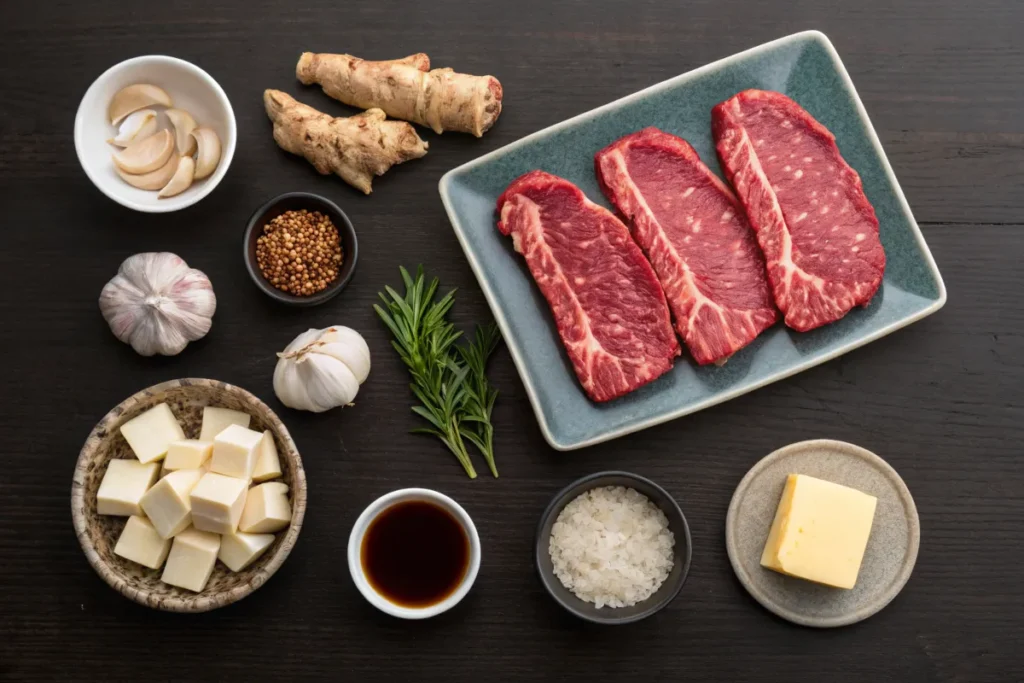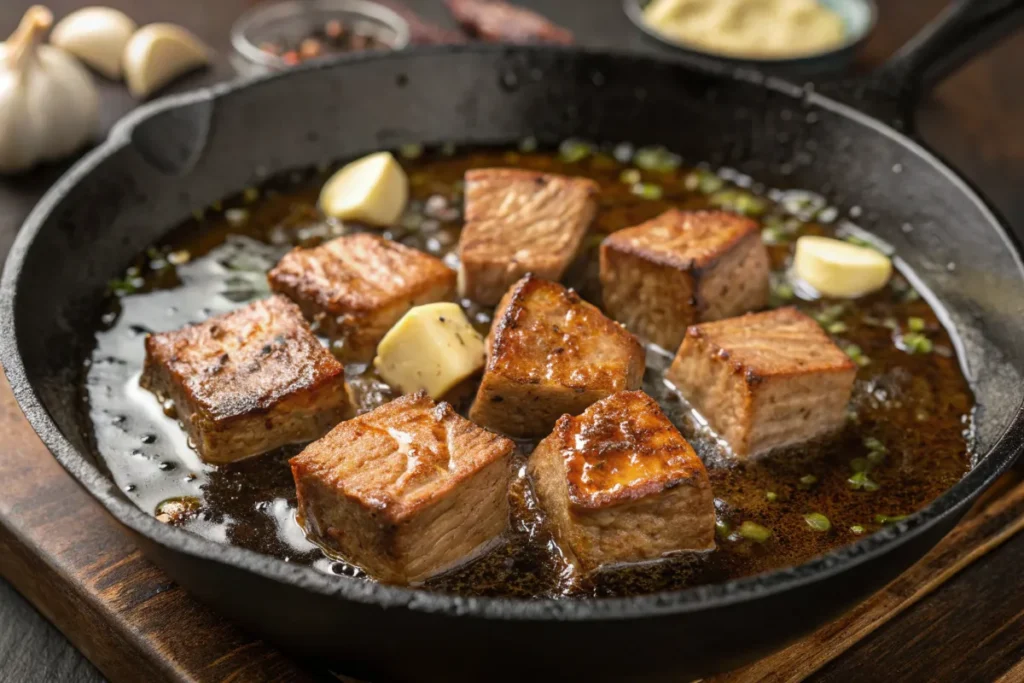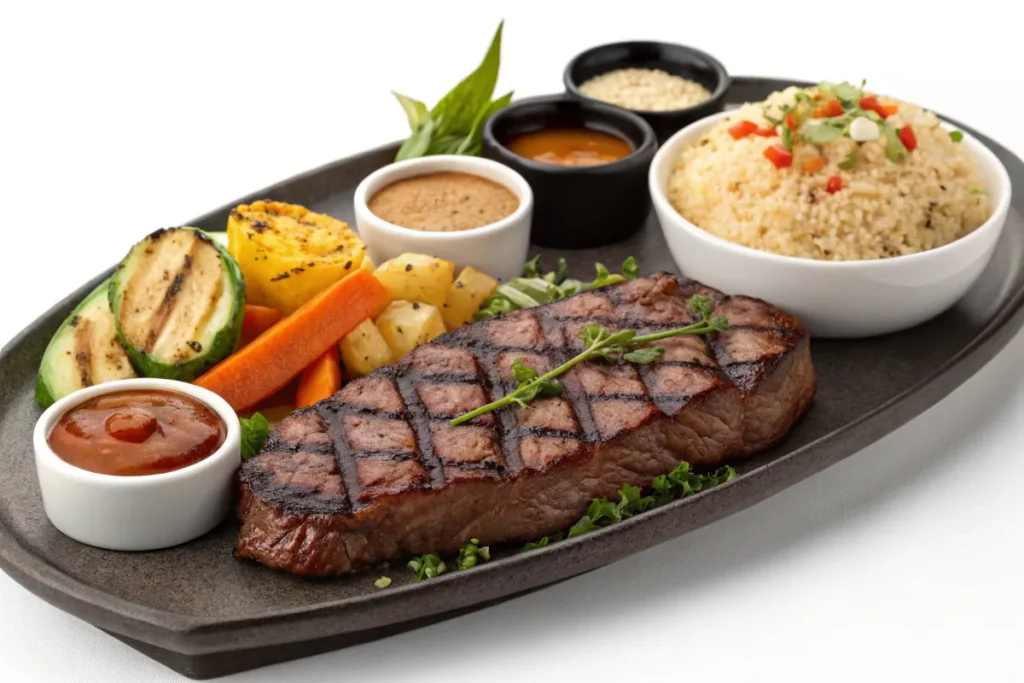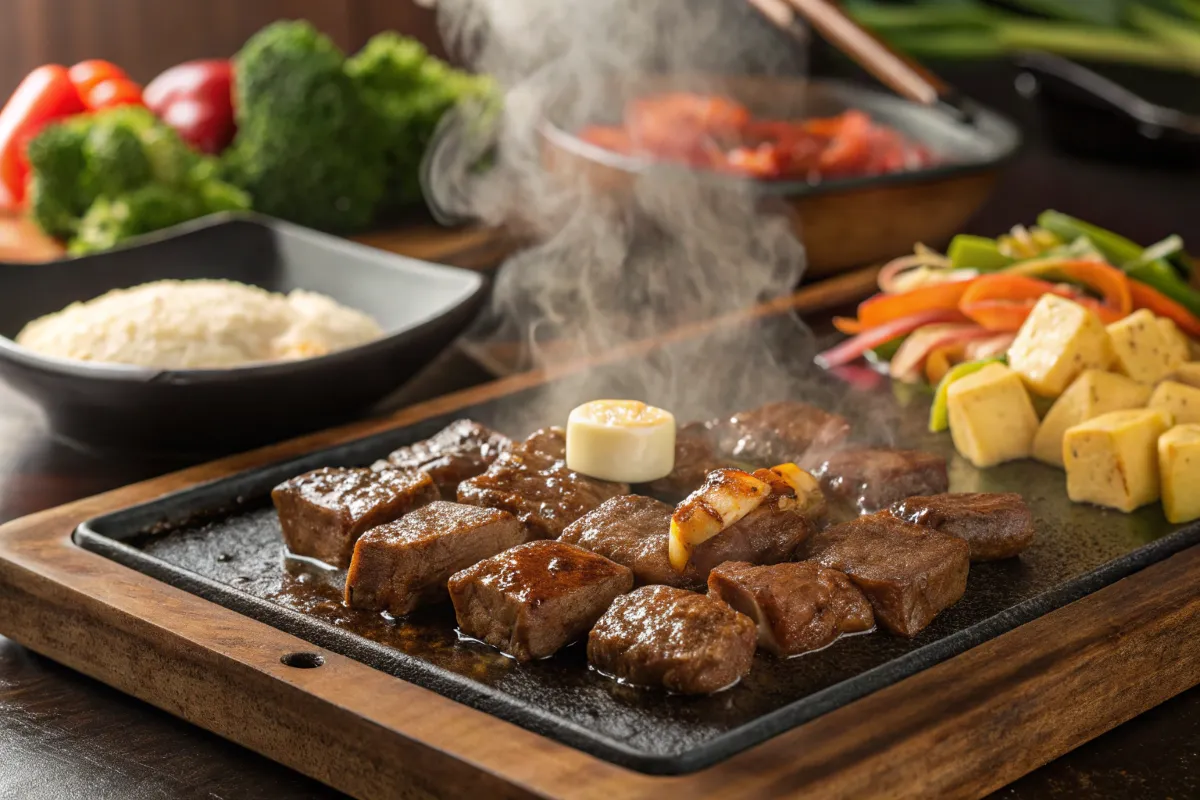Introduction
Craving that sizzling, savory hibachi steak you usually get at a Japanese steakhouse? Good news—you can recreate that exact same magic in your own kitchen! This hibachi steak recipe guide will walk you through everything you need: from choosing the best cut of beef to crafting your own garlic butter, yum yum sauce, and even sides like hibachi fried rice and vegetables.
Whether you’re planning a family dinner, a backyard hibachi night, or just want to elevate your weeknight meals, this guide will show you how to master the hibachi steak recipe like a pro. Along the way, we’ll explore tools, tips, variations, common mistakes to avoid, and answer your most-searched questions.
Ready to fire up the grill or skillet? Let’s dive in.
What Is Hibachi Steak?
The Origin of Hibachi-Style Cooking
When most people think of hibachi, they picture the dazzling, interactive cooking style from restaurants like Benihana—where chefs flip shrimp into hats and create onion volcanoes. But hibachi actually refers to a traditional Japanese cooking method where food is grilled over an open flame using a small, portable barbecue grill.
In Japanese, “hibachi” literally means fire bowl. It was originally a heating device, but over time, the word evolved—especially in the U.S.—to describe teppanyaki-style cooking. While technically teppanyaki is done on a flat iron griddle, Americans commonly use “hibachi” to refer to this entire experience. And yes, that includes the juicy, sizzling steak that’s the star of the show.
What Makes Hibachi Steak So Irresistible?
Unlike regular grilled steak, a hibachi steak recipe involves more than just meat and salt. It’s all about the layers of flavor—soy sauce, garlic, butter, and ginger often lead the way. The steak is usually cut into bite-sized pieces, seared quickly over high heat, and finished with a glossy sauce that clings to every tender bite.
Pair it with fried rice, veggies, and yum yum sauce, and you’ve got yourself a full-on Japanese steakhouse experience at home.
Fun Fact: Hibachi steak is often served alongside sesame garlic noodles, stir-fried vegetables, and hibachi-style rice. You’ll learn how to make those too, later in this guide!
Key Ingredients for the Best Hibachi Steak Recipe
Choosing the Right Cut of Steak
When it comes to making a great hibachi steak recipe, the cut of beef makes a big difference. Ribeye is rich and juicy thanks to its marbling, while sirloin is leaner but still flavorful. If you want something ultra-tender, filet mignon is the gold standard—but also the priciest.
No matter what you choose, aim for high-quality, fresh meat. Grass-fed beef has a deeper flavor, while grain-fed tends to be milder and fattier. Just make sure your steak is at least ¾ to 1 inch thick for that perfect sear.
Pro Tip: Let your steak rest at room temperature for 30 minutes before cooking. It helps cook more evenly and stay juicy inside.
Essential Sauces and Marinade Basics

What makes the hibachi steak recipe so crave-worthy is the flavor-packed marinade. The classic mix usually includes:
- Soy sauce – brings umami and saltiness
- Sesame oil – for a nutty, rich aroma
- Minced garlic and ginger – adds punch and zest
- Butter – for that restaurant-style glossy finish
- Sugar or mirin – adds subtle sweetness
Some chefs also add a splash of sake or rice vinegar for a tangy lift. Marinate your steak for 30 minutes to 2 hours max. Anything longer can break down the texture.
Want to add some heat? A dash of sriracha or chili paste turns up the fire.
Tools and Equipment for Hibachi Cooking
Best Cooking Surface for Hibachi-Style Searing

You don’t need a restaurant grill to master a hibachi steak recipe. At home, the best choices are:
- Flat-top griddle – mimics the hibachi setup
- Cast-iron skillet – retains heat and gives a great crust
- Non-stick pan – easy cleanup, but less sear
The key is high heat. Hibachi steak cooks fast, so your pan should be smoking hot before the meat hits it. Don’t overcrowd the pan—steak needs space to brown, not steam.
If you want to take it outdoors, a propane flat-top or grill with a cast-iron plate works beautifully.
Must-Have Utensils and Prep Tools
Cooking hibachi-style means staying organized. Here are tools that make life easier:
- Metal spatulas – for flipping and scraping like a pro
- Oil squeeze bottle – adds flavor and helps control splatter
- Tongs – ideal for flipping steak quickly
- Prep bowls – for separating sauces, veggies, and meats
And don’t forget: a good knife is essential for slicing your steak before or after cooking. Thin, even cuts = better flavor and texture.
For more delicious ideas to pair with your steak, explore our brisket chili recipe—a bold, comforting dish with smoky depth.
Common Mistakes to Avoid
Overcooking the Steak: Timing is Everything
One of the biggest mistakes people make when preparing a hibachi steak recipe is overcooking the meat. Hibachi-style cooking is fast, and your steak can go from perfectly juicy to rubbery in seconds. Always cook on high heat, but keep a close eye on the internal temperature—medium-rare (130–135°F) is the sweet spot for that tender, flavorful bite.
Additionally, make sure the steak is room temperature before hitting the grill. Cold steak seizes up when it touches a hot pan, making it chewy instead of succulent.
Skipping the Resting Period
After cooking your steak, resist the urge to slice it right away. Letting the meat rest for 5–10 minutes allows juices to redistribute, giving you that melt-in-your-mouth texture. Skipping this step often leads to dry, unevenly cooked steak.
Another thing—don’t forget to slice against the grain. This cuts through muscle fibers and makes every bite easier to chew, especially important for lean cuts like sirloin.
Hibachi Sauces and Dipping Options
Yum Yum Sauce and Other Staples
If you’ve ever eaten at a hibachi grill, you know the magic of yum yum sauce. It’s creamy, tangy, and just a little bit sweet—made with mayo, ketchup, butter, sugar, and a dash of garlic powder. This sauce is the perfect match for your hibachi steak recipe, balancing the savory meat with a cool contrast.
Another classic is ginger sauce, which blends soy sauce, fresh ginger, garlic, vinegar, and onion. It’s bold, a little spicy, and cuts through the richness of steak beautifully.
Make-At-Home Hibachi Sauce Tips
When making sauces at home, start with small batches. This way, you can tweak the flavors as needed. Want more heat? Add sriracha. Want it tangier? A splash of rice vinegar does the trick. For creamy sauces, always whisk ingredients until fully emulsified to avoid separation.
Not a fan of dairy? Try a vegan-friendly option using plant-based mayo and coconut yogurt. It’s still creamy but fits a dairy-free lifestyle.
Variations of the Hibachi Steak Recipe
Gluten-Free and Low-Sodium Options
Want to enjoy your favorite hibachi steak recipe without gluten or too much salt? You totally can. First, switch out traditional soy sauce for tamari or coconut aminos. These still deliver that savory punch but without the gluten or high sodium levels.
Also, make your own hibachi sauce instead of using bottled versions. That way, you can control the salt and sugar. Use fresh garlic, ginger, and sesame oil for flavor without compromise.
And if you’re really looking to cut down on sodium, use low-sodium broth as a marinade base and skip the added salt altogether. The flavor will still shine—promise!
Spicy, Sweet, and Keto-Friendly Variants
Ready to shake things up? Add sriracha or chili flakes to give your hibachi steak a spicy twist. Want a touch of sweetness? A drizzle of honey, maple syrup, or even pineapple juice in the marinade brings balance and depth.
For keto lovers, skip any sugar or cornstarch-based sauces and instead go for butter, garlic, and soy sauce (or coconut aminos). Pair with grilled zucchini or cauliflower rice instead of fried rice for a low-carb meal that still satisfies every craving.
Experimenting with your hibachi steak recipe keeps things fun—and might just help you find your new go-to version!
For another mouthwatering variation, check out this hibachi steak recipe here, which offers a flavorful twist with garlic butter and sizzling vegetables
Serving and Presentation Tips

Plating Your Hibachi Steak Recipe Like a Pro
Great food deserves great presentation. When serving your hibachi steak recipe, think restaurant-style. Slice the steak into bite-sized pieces and fan them out over a small mound of fried rice or alongside stir-fried veggies.
Sprinkle toasted sesame seeds on top for texture, and add a few scallion curls for color. If you’ve made multiple sauces—like yum yum and ginger—serve them in small dipping bowls on the side. Not only does this look great, but it also adds flexibility for your guests.
Make It a Full Hibachi Experience at Home
Want to take it a step further? Turn your meal into a DIY hibachi night! Set up a portable griddle (or even use a large electric skillet on your table), and let guests watch as you cook. It’s interactive, fun, and turns dinner into a mini event.
Offer small plates of shrimp, chicken, and mushrooms as sides. Add some hibachi noodles or miso soup to round out the meal. And don’t forget your drinks—Japanese beer, sake, or even sparkling water with lemon go perfectly.
This hibachi steak recipe isn’t just about eating—it’s about the experience. Make it memorable!
FAQs – People Also Ask
What cut of beef is best for a hibachi steak recipe?
The most popular cuts for a hibachi steak recipe are sirloin, ribeye, and filet mignon. Sirloin is lean and budget-friendly, ribeye offers marbling and tenderness, and filet is the most tender of them all. Your choice depends on your taste and how tender you like your steak.
What seasonings do hibachi chefs use?
Hibachi chefs rely on a simple but bold seasoning mix. The base includes soy sauce, garlic, ginger, black pepper, and sesame oil. Some also add a touch of butter and sugar for that signature caramelized glaze that clings to each bite of steak.
Can I cook hibachi steak without a grill?
Absolutely! You don’t need a fancy flat-top grill. A cast-iron skillet or non-stick frying pan works perfectly for making a delicious hibachi steak recipe at home. Just heat it until it’s very hot and cook the steak in small batches.
What sauce goes best with hibachi steak?
The most common pairings include yum yum sauce, ginger sauce, and mustard sauce. Each one brings something different—yum yum is creamy and sweet, ginger is zesty, and mustard adds a tangy punch.
Final Thoughts + Printable Hibachi Steak Recipe
Bringing It All Together
By now, you’ve got everything you need to make an unforgettable hibachi steak recipe. From picking the right cut to mastering the sauces, you’re ready to cook like a pro—even without the teppanyaki grill. Whether you’re feeding the family or hosting guests, hibachi-style meals add flair to your dinner table.
If you haven’t tried your hand at it yet, now’s the perfect time. Just remember: hot skillet, fresh ingredients, and don’t skip the sauces!
Printable Hibachi Steak Recipe
Ingredients:
- 1 lb sirloin or ribeye steak, cut into cubes
- 2 tbsp soy sauce
- 1 tbsp butter
- 1 tsp garlic (minced)
- 1 tsp sesame oil
- Salt and pepper to taste
Instructions:
- Heat a cast-iron skillet over high heat.
- Add sesame oil and butter.
- Add steak cubes and sear for 2–3 minutes.
- Add soy sauce and garlic, stir-fry for another 1–2 minutes.
- Serve hot with hibachi veggies or fried rice.
Enjoy your homemade hibachi steak recipe—it’s restaurant-quality made simple.
Try it and share your experience with us!

